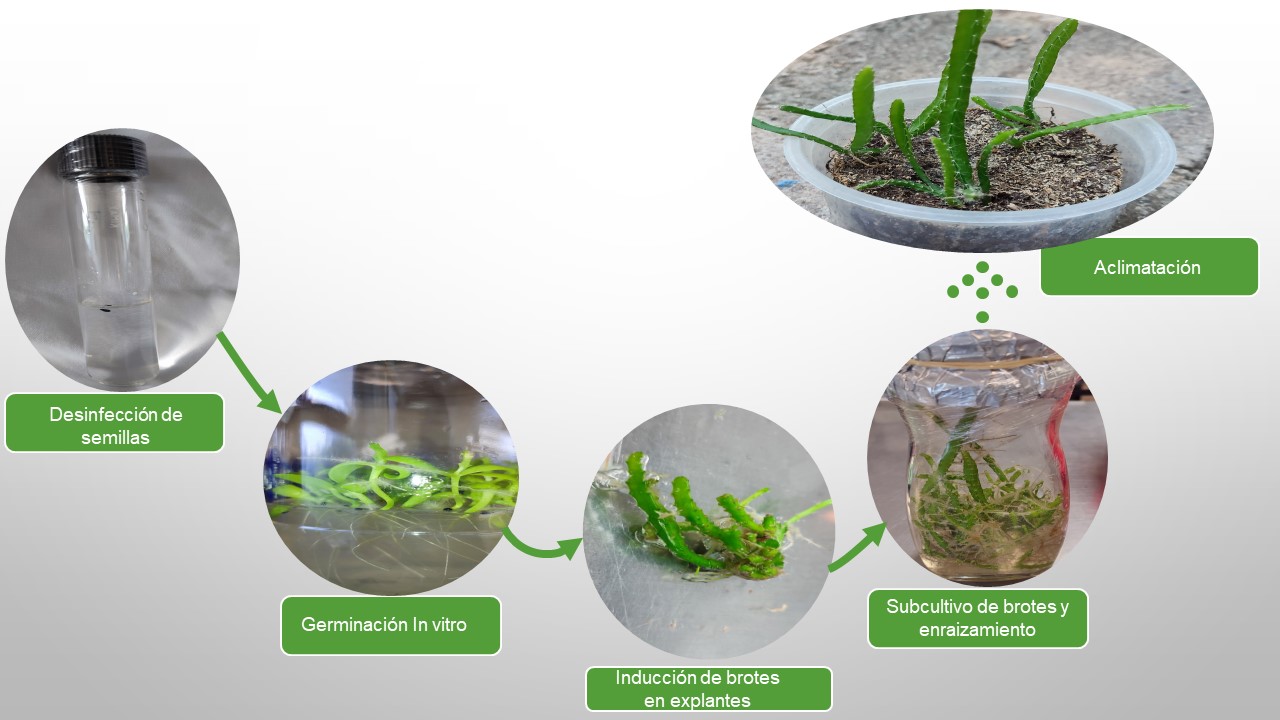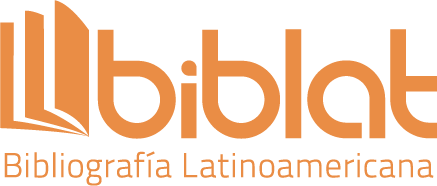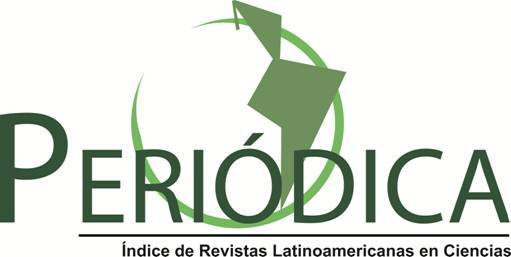Germinación de semillas y propagación in vitro de pitahaya (Hylocereus undatus)
DOI:
https://doi.org/10.18633/biotecnia.v27.2366Palabras clave:
Desinfección, Germinación, Organogénesis, AclimataciónResumen
Hylocereus undatus, comúnmente conocido como fruta
del dragón o pitahaya, es una especie de cactus trepador
perteneciente a la familia Cactaceae. Este cultivo ha ganado
popularidad a nivel mundial debido a su apariencia llamativa, su sabor dulce y exótico. Además, su contenido de antioxidantes, vitaminas y minerales, lo convierte en un cultivo valioso y de gran importancia económica en diversas regiones tropicales y subtropicales del mundo. Por ello, el objetivo de esta investigación fue evaluar diferentes protocolos para la desinfección de semillas y la propagación in vitro de Hylocereus undatus. Las semillas se extrajeron de frutos maduros, fueron desinfectadas con NaClO al 50 % (v/v) y etanol al 70 % (v/v), variando los tiempos de inmersión. Para la germinación, las semillas desinfectadas se establecieron en medio Murashige y Skoog (MS) al 50 % de sales, suplementado con 30 g/L de sacarosa y 2.5 g/L de fitagel. Posteriormente, para la inducción de brotes se emplearon explantes de tallos, hipocótilos, cotiledones y reguladores de crecimiento como ácido naftalenacético (ANA), bencilaminopurina (BAP) y ácido 2,4-diclorofenoxiacético (2,4-D) en concentraciones de 0 y
2 mg/L. Con respecto a la desinfección los resultados mostraron que el protocolo 2 donde se empleó NaClO al 50 % (v/v) durante 10 min de inmersión, indujo 100 % de desinfección y 85 % de germinación. En la inducción de brotes se observó que los tratamientos suplementados con ácido naftalenacético y bencilaminopurina indujeron la formación de brotes en explantes de tallos, el mayor número de brotes (15.11) se obtuvo con 2 mg/L de BAP. Finalmente, en la aclimatación de vitro plantas a nivel invernadero se logró una sobrevivencia del 90 % empleando peat moss y perlita como sustratos. Estos hallazgos destacan la efectividad del protocolo diseñado para la propagación in vitro de H. undatus, contribuyendo potencialmente a su producción comercial.
Descargas
Citas
Ali, M. J., Murdad, R., & Latip, M. A. 2011. In vitro seed germination of Bornean endemic orchids Dendrobium tetrachromum and Dendrobium hamaticalcar. Empower. Science Technology Innovation: Towards Better Tomorrow, UMTAS, 770-778.
Bougdaoua, H., El Mtili, N. 2020. In vitro regeneration of two northern Moroccan Opuntia ficus-indica (L.) Mill. genotypes. Moroccan Journal Biology. 17, 36–42.
Cálix, R., Castillo, R., Rodriguez, A., & Castañeda, R. 2005. El cultivo de la pitahaya en el trópico. Instituto para el Desarrollo de Sistemas de Producción, 50-58.
El Finti, A., El Boullani, R., Belayadi, M., Ait Aabd, N., and El Mousadik, A. 2010. Micropropagation in vitro of Opuntia ficus-indica in Southern Morocco. International Journal of Chemical and Biochemi-cal Sciences. 995, 93–98
Esquivel, P. y Y. Araya-Quesada. 2012. Características del fruto de la pitahaya (Hylocereus sp.) y su pontecial uso en la industria alimentaria. Revista Venezolana de Ciencia y Tecnologia de Alimentos 3 (1): 113-129.
Hailu, A., Sbhatu, D. B., & Abraha, H. B. 2020. In vitro micropropagation of industrially and medici-nally useful plant Aloe trichosantha berger using offshoot cuttings. The Scientific World Journal.
Ibrahim, S. R. M., Mohamed, G. A., Khedr, A. I. M., Zayed, M. F., & El‐Kholy, A. A. E. S. 2018. Genus hylocereus: beneficial phytochemicals, nutritional importance, and biological relevance—A re-view. Journal of Food Biochemistry, 42(2), e12491.
Kasim, H., Yusran, Y., & Basri, Z. 2016. The strength of MS media and sterilization technique on red dragonfruit (Hylocereus polyrhizus) seed germination. Agroland The Agricultural Sciences Journal (e-Journal), 2(1).
Le Bellec, F., Vaillant, F., & Imbert, E. 2006. Pitahaya (Hylocereus spp.): a new fruit crop, a market with a future. Fruits, 61(4), 237-250.
McDonald, M. B. (1994). Seed germination and seedling establishment. Physiology and determination of crop yield, 37-60.
Muñoz-Castellanos, L. N., Borrego-Loya, A., Villalba-Bejarano, C. V., González-Escobedo, R., Ordu-ño-Cruz, N., Villezcas-Villegas, G. P. & Vargas-Arispuro, I. (2021). Chlorine and its importance in the inactivation of bacteria, can it inactivate viruses?. Revista Mexicana de Fitopatología, 39(SPE), 198-206.
Murashige T & Skoog F. 1962. A revised medium for rapid growth and bioassays with tobacco tissue cultures. Physiology Plant 15: 473–497.
Oyebanji, O.B., Nweke O., Odebunmi O., Galadima N.B., Idris M.S., Nnodi U.N., Afolabi A.S. and Ogbadu G.H., 2009. Simple, effective and economical explant-surface sterilization protocol for cow-pea, rice and sorghum seeds. African Journal of Biotechnology. Vol. 8 (20), pp. 5395-5399.
Ortiz-Hernández, Y. D., y Carrillo-Salazar J. A. 2012. Pitahaya (Hylocereus spp.): A short Review. Comunicata Scientiae 3 (4): 200-237
Raja, R. H. S., Wani, M. S., Mushtaq, R., Bhat, Z. A., Malik, A. R., & Javid, K. 2018. Effect on vege-tative growth and reproductive development of Chinese sand pear (Pyrus pyrifolia) treated with various growth controlling strategies. Journal of Pharmacognosy and Phytochemistry, 7(4), 18-24.
Ramírez-Delgadillo, J. J., Rodríguez-Leyva, E., Livera-Muñoz, M., Pedroza-Sandoval, A., Bau-tista-Martínez, N., & Nava-Díaz, C. 2011. First report of cactophagus spinolae (gyllenhal) (coleoptera: curculionidae) on three species of hylocereus (cactaceae) in Morelos, Mexico. Acta Zoológica Mexicana (N.S.), 27(3), 863–86
Rodriguez, O. J. L., y Ramirez-Pantoja, P. E. 2020. Micropropagation of selected materials of Opuntia ficus indica L through culture in vitro of areola. Journal of Applied Biotechnology & Bioengineering. 7, 121–126
Shadang, R., Dwivedi Padmanabh, Hegde N.S and Ahmed N, 2007. Effect of different culture media on seed germination and subsequent in vitro development of protocorms of Hygrochilus parishii. Indian Journal of Biotechnology. Vol 6 Pg. 256-261.
Sheng, W.K.W., Sundarasekar, J., Sathasivam, K., Subramaniam, S. 2016. Effects of plant growth reg-ulators on seed germination and callus induction of Hylocereus costaricensis. Pakistan Journal of Bo-tany 48 (3), 977-982.

Publicado
Cómo citar
Número
Sección
Licencia
Derechos de autor 2025

Esta obra está bajo una licencia internacional Creative Commons Atribución-NoComercial-CompartirIgual 4.0.
La revista Biotecnia se encuentra bajo la licencia Atribución-NoComercial-CompartirIgual 4.0 Internacional (CC BY-NC-SA 4.0)









_(2).jpg)






